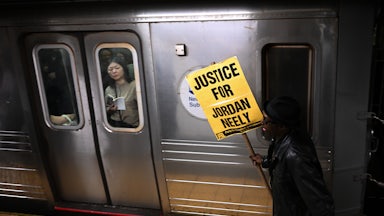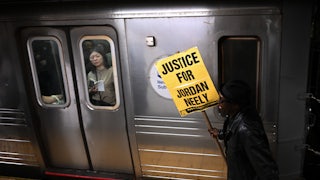For most of the country, Daniel Penny was in the wrong place at the wrong time: The 24-year-old Marine veteran confronted an erratically behaving homeless man named Jordan Neely on a New York City subway last month, killing him. Captured on cell phone video, the tragic incident went viral and became national news.
For the right-wing press, pundits, and politicians, however, Penny was the right man in the right place at the right time. He fits the right’s narrative that liberal cities are overrun with drugged-up vagrants who threaten the safety of helpless, law-abiding Americans. Manhattan District Attorney Alvin Bragg’s decision to charge Penny with second-degree manslaughter only strengthened the right-wing depiction of Penny as a hero.
On Fox News, one host decried the decision as “pro-criminal” and “anti-hero.” In mid-May, as Ron DeSantis was desperately trying to recraft his persona into something appealing to the Republican base, he tweeted that “we must defeat the Soros-Funded DAs, stop the Left’s pro-criminal agenda, and take back the streets for law-abiding citizens. We stand with Good Samaritans like Daniel Penny.” In the New York Post, columnist Rich Lowry declared that “Daniel Penny is not a vigilante.”
But where is the line between good Samaritan and vigilante? To justify his argument, Lowry cites the Merriam-Webster dictionary definition of vigilante but, of course, that’s a laughably simplistic answer to such a nuanced question. What has become clear over the past few years, through the right-wing embrace of other Penny-like figures—Kyle Rittenhouse or Mark and Patricia McCloskey—is that the right-wing political ecosystem craves vigilantes. Especially if those vigilantes can be whitewashed into good Samaritans or even heroes.
And vigilantes who act in liberal cities, as in the cases of Penny and Rittenhouse, are even more welcome on the right. There was noticeably less support for Travis and James McMichael, the white men who chased down and murdered black jogger Ahmaud Arbery on a tree-lined road in rural Georgia, claiming they thought he was a burglar. On the right-wing crowdfunding site GiveSendGo, the McMichaels’ defense fund has raised just over $37,000. Penny’s defense fund on the same site—apparently set up by his lawyers—has raised nearly $3 million.
It’s no coincidence that they’re soliciting donations through GiveSendGo, which Rittenhouse also used, and not the mainstream crowdfunding site GoFundMe. Penny’s lawyers understand that their client fits neatly into the right’s established narrative. Despite his lawyers’ claim that “there’s nothing political about this case,” it’s also no coincidence that Penny gave his first interview to the New York Post rather than a more intellectually rigorous outlet. Penny’s lawyers are also aware of their case’s dimensions and the public arena in which it is to be tried. They have appeared on Fox News and CNN, and during one appearance on Chris Cuomo’s new late-night show, one of Penny’s lawyers claimed that their client “wasn’t choking anyone. What he was doing was he was restraining someone.”
But there are plenty of other ways of restraining someone. In fact, anybody familiar with hand-to-hand combat or even anybody who has worked as a bouncer at a bar knows that a choke hold is a terrible way of restraining someone. There are two kinds of choke holds: a blood choke, which closes the carotid artery in the neck and cuts off blood supply to the brain; and an air choke, which closes the trachea and stops breathing. Penny used a blood choke to kill Jordan Neely, and furthermore, Penny locked his choke—placing his hand on the back of Neely’s head as a fulcrum, a step that increases its effectiveness. The goal of an effective choke hold is not to restrain the victim, however, it’s to render them unconscious.
Prosecutors will have to prove that Penny’s decision to apply a blood choke to a homeless man on the floor of a New York City subway constituted an “unjustifiable risk” and that Penny was “aware of and consciously disregarded that risk”—those are the instructions that a New York state judge gives to a jury considering second-degree homicide. Penny’s lawyers have argued that their client was acting in self-defense, telling the New York Post, “The threats, the menacing, the terror that Jordan Neely introduced to that train has already been well documented.” New York’s self-defense statute says that “arguing, using abusive language, calling a person names, or the like, unaccompanied by physical threats or acts, does not make a person an initial aggressor and does not justify physical force.”
Much of the right-wing press’s coverage of the fatal confrontation between Penny and Neely has been focused on the latter’s history, portraying it as one gross moral failure after another. The Spectator describes Neely as “a thirty-year-old schizophrenic drug addict … [who] cut a swathe of destruction and fear through New York’s streets and subways for fifteen years.” As he introduced the story of Neely’s death, Fox News’ Brian Kilmeade told viewers that “this man, who died, has numerous other arrests for assault, disorderly conduct and fare beating, according to law enforcement.”
But again, this is a trend among the right: to draw attention away from the fatal confrontation and instead to focus on the victims’ sometimes unsavory history. It’s a way of justifying vigilantism and, more appallingly, a way of justifying the deaths of people like Jordan Neely, George Floyd, and Eric Garner. And maybe Kilmeade wasn’t suggesting that Neely deserved to die. But he wasn’t suggesting that Neely deserved to live either.
Sometimes this right-wing characterization reaches outright misinformation: After George Floyd was murdered by a police officer kneeling on his neck, Tucker Carlson falsely claimed Floyd died from a drug overdose. Despite constant debunking, the narrative remains popular on the right. Mark Brodin, a law professor at Boston College who has studied vigilantism, told me that the right’s mischaracterizations of these confrontations represent “the worst kind of cynical manipulation of truth, and it has the most deleterious impact on our society because it legitimizes public killing of other citizens under the guise that you were in fear of them.”
The supposed truth holding up this right-wing justification of vigilantism—the notion that Neely was such a threat to passengers that somebody had to do something about it—has not been supported by any of the video evidence released. The only thing the three-minute-long video does show is Daniel Penny choking Jordan Neely to death.
If nothing else, this speaks to the right’s eagerness to assume facts that uphold their narrative, for which vigilantism is crucial. Matthew Dallek, a professor of political management at George Washington University told me that the conservative attitude about vigilantism reflects “an intersection of these larger ideas that many on the far right hold about the breakdown of society and the breakdown of cities in particular—the need for citizens to arm themselves, to protect themselves, and to defend themselves against lawlessness.”
Such notions have long reverberated within the Republican Party, but the Trump era pushed them into the right’s mainstream (or, perhaps, pushed the right’s mainstream to them). Vigilantes have become heroes on the modern right. Rittenhouse enjoyed a conservative media tour and a meeting with Donald Trump in the weeks after he was acquitted. The McCloskeys, the couple who gained national attention for standing outside their posh home and waving guns at marchers protesting police brutality, spoke at the 2020 Republican National Convention. Texas Governor Greg Abbott has promised to pardon a Texan recently convicted of murdering a man at a Black Lives Matter protest.
It’s difficult to say if these vigilante incidents have become more common since Trump’s ascendance or if they’ve always occurred and we’ve only become more cognizant of them. Certainly, the ubiquity of cell phone cameras shines a new light on vigilantism. But it has a long history in America. D.W. Griffith’s The Birth of a Nation—the first film ever screened at the White House—lauds the Ku Klux Klan’s vigilantism. Practically every Western ever made features some vigilante who takes the law into his own hands, as does the superhero genre. Penny has been compared to Bernhard Goetz, the 37-year-old New Yorker who shot four African American teens on a New York subway in 1984 and became a national lightning rod—a hero or vigilante villain, depending on your political views. So maybe none of this is new, but never before has there been such a desire for vigilantes. Never before have vigilantes fit so well into such a unified political narrative. And like the right’s indifference to mass shootings, this hunger for vigilantism is a relatively recent development. Let’s hope it doesn’t stick.










